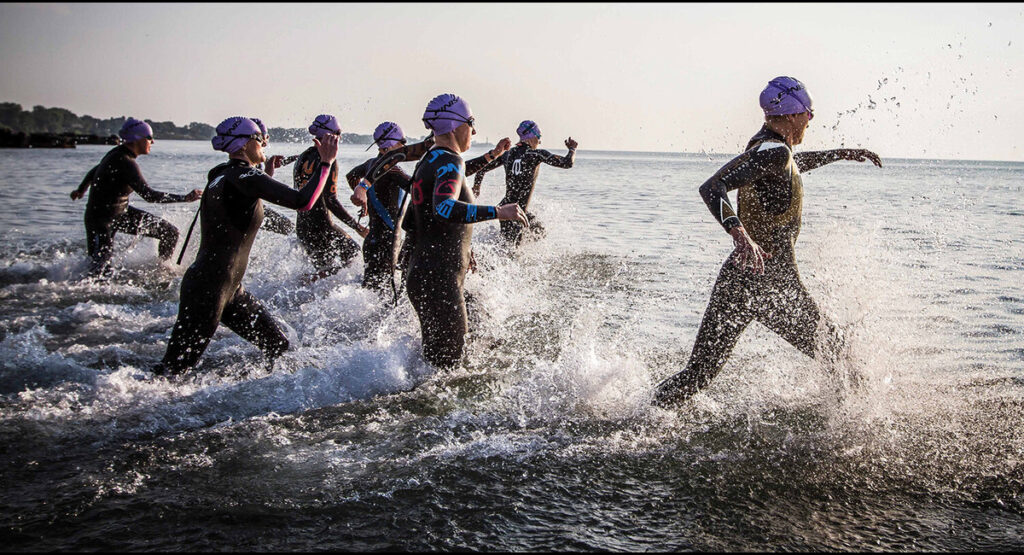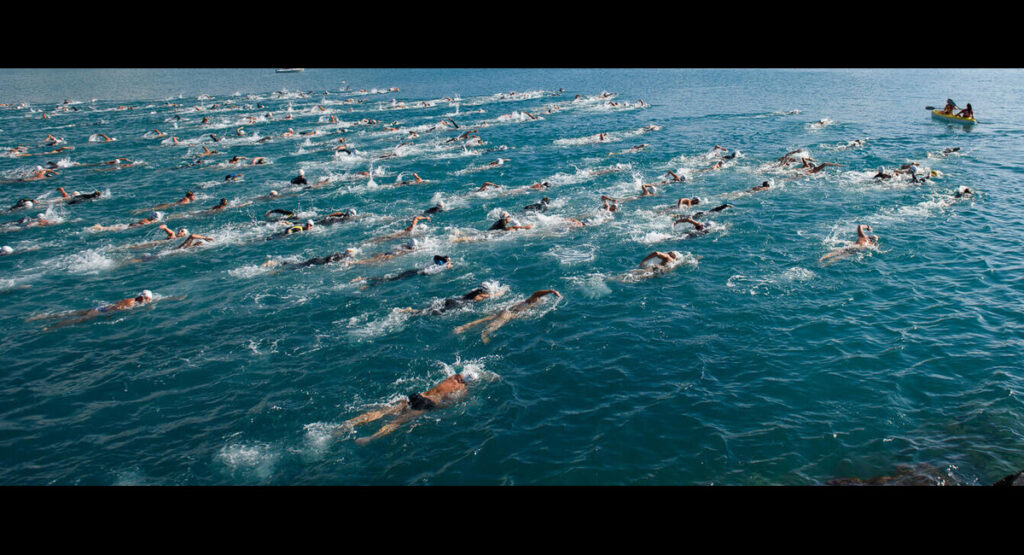
Introduction
Swimming often stands out as the most challenging leg for triathletes. It’s not just about fitness—navigating open water, managing technique, and staying calm amid a crowd can be daunting, even for seasoned athletes. Yet, mastering swimming can significantly improve your overall triathlon performance and confidence.
This guide will help you develop the essential swimming skills for triathlons. It covers technique, training plans, must-have gear, and race-day tips. Whether preparing for your first sprint triathlon or tackling a full Ironman, these insights will set you up for success.
1. Understanding the Role of Swimming in a Triathlon
Swimming is the first leg of a triathlon, setting the tone for the entire race. Here’s a quick look at the standard distances:
| Triathlon Type | Swim Distance |
|---|---|
| Sprint | 750m |
| Olympic | 1.5km |
| Half-Ironman | 1.9km |
| Ironman | 3.8km |
Open-water swimming has unique challenges, including dealing with waves, limited visibility, and crowded starts. Learning to navigate these conditions effectively ensures you conserve energy and begin the race with a strong foundation.
2. Building a Strong Foundation: Swimming Technique
A solid technique is crucial for efficiency and endurance. Focus on these key aspects:
- Body Position: Keep your body aligned and balanced to reduce drag in the water.
- Breathing Techniques: Practice bilateral breathing to stay relaxed and maintain a rhythm.
- Freestyle Stroke Fundamentals:
- Arm Entry and Pull: Enter the water with a slight angle and pull back with power.
- Kick Technique: Use a steady, streamlined kick to support your stroke.
- Streamlining and Rotation: Rotate your torso for an efficient stroke and a natural flow.
Common Mistakes: Avoid over-kicking, poor hand positioning, and unnecessary head lifting, which wastes energy.
3. Training for Triathlon Swimming
Pool vs. Open Water: While pool training helps refine your technique, practicing in open water simulates race-day conditions.
Training Plans:
- Determine your weekly swim volume based on the race distance.
- Balance swimming with biking and running training to avoid overtraining.
Drills to Improve:
- Catch and Pull Drills: Enhance the strength and efficiency of your stroke.
- Breathing Drills: Practice rhythmic breathing for endurance.
- Sighting Practice: Learn to lift your head to spot buoys without breaking your stroke.
Incorporate interval training to build speed and endurance, alongside long, steady swims for stamina.
4. Essential Gear for Triathlon Swimming
| Gear | Importance |
| Wetsuits | Choose one suited to water temperature. |
| Goggles | Anti-fog, UV protection, and a snug fit. |
| Swim Caps | Bright colors for visibility in open water. |
| Training Gear | Paddles, pull buoys, and kickboards for technique. |

5. Open-Water Swimming Tips
- Prepare Early: Familiarize yourself with open-water conditions well before race day.
- Sighting Techniques: Practice spotting landmarks or buoys to stay on course.
- Stay Calm: Use breathing techniques to manage anxiety, especially during crowded starts.
- Handle Waves: Use controlled breathing and adapt your stroke to deal with rough waters.
6. Race-Day Strategies
- Warm-Up: Start with light swimming and dynamic stretches to loosen up.
- Positioning: Choose your start position wisely—front for fast swimmers, back or side for beginners.
- Pacing: Maintain a steady rhythm to conserve energy for the bike and run.
- Transition Tips (T1): Practice removing your wetsuit quickly and setting up your gear for a seamless transition.
7. Common Challenges and How to Overcome Them
| Challenge | Solution |
| Fear of Open Water | Gradual exposure and practice for confidence. |
| Cramping | Stay hydrated and fuel with electrolytes. |
| Improving Swim Times | Focus on technique and interval training. |
8. Additional Resources and Tools
- Coaching Programs: Join a triathlon-specific swim class or work with a coach.
- Apps and Gadgets: Use tools like swim watches or apps for tracking progress.
- Books and Videos: Check out resources like “Total Immersion” by Terry Laughlin or video tutorials on YouTube.
Frequently Asked Questions (FAQ)
Q: How often should I practice swimming for a triathlon? A: Aim for 3-4 swim sessions per week, incorporating a mix of technique drills, endurance, and speed work.
Q: How do I overcome anxiety in open water? A: Practice in open water regularly, focus on controlled breathing, and start with smaller groups to build confidence.
Q: What’s the best way to improve my swim times? A: Focus on technique improvements and include interval training to build speed and endurance.
Q: Do I need a wetsuit for triathlon swimming? A: Wetsuits are recommended for colder water temperatures and can improve buoyancy and speed. Check race guidelines for requirements.
Q: How do I sight effectively during open-water swims? A: Practice lifting your head briefly during your stroke to spot buoys or landmarks, and integrate this skill into training sessions.
Conclusion
Swimming is more than just the start of a triathlon; it’s your chance to build momentum for the race ahead. By focusing on technique, investing in proper training, and preparing mentally and physically, you can transform swimming from a challenge into your strength.
Take the plunge today—commit to consistent practice and embrace the journey toward triathlon success!